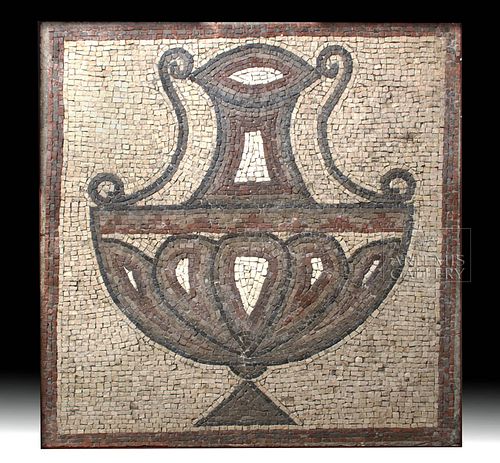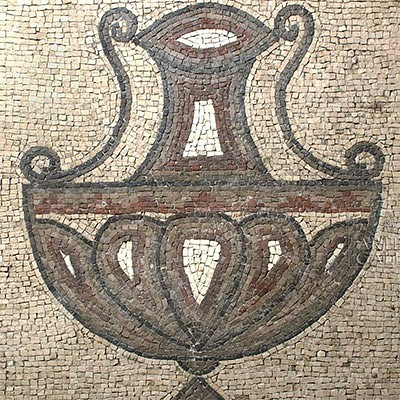Roman Stone Mosaic Art - Elegant Amphora
Lot 96
About Seller
Artemis Gallery
686 S Taylor Ave, Ste 106
Louisville, CO 80027
United States
Selling antiquities, ancient and ethnographic art online since 1993, Artemis Gallery specializes in Classical Antiquities (Egyptian, Greek, Roman, Near Eastern), Asian, Pre-Columbian, African / Tribal / Oceanographic art. Our extensive inventory includes pottery, stone, metal, wood, glass and textil...Read more
Categories
Estimate:
$13,000 - $19,500
Absentee vs Live bid
Two ways to bid:
- Leave a max absentee bid and the platform will bid on your behalf up to your maximum bid during the live auction.
- Bid live during the auction and your bids will be submitted real-time to the auctioneer.
Bid Increments
| Price | Bid Increment |
|---|---|
| $0 | $25 |
| $300 | $50 |
| $1,000 | $100 |
| $2,000 | $250 |
| $5,000 | $500 |
| $10,000 | $1,000 |
| $20,000 | $2,500 |
| $50,000 | $5,000 |
| $100,000 | $10,000 |
| $200,000 | $20,000 |
About Auction
By Artemis Gallery
Sep 22, 2020
Set Reminder
2020-09-22 12:00:00
2020-09-22 12:00:00
America/New_York
Bidsquare
Bidsquare : Antiquities - Egypt, Greece, Italy, Near East
https://www.bidsquare.com/auctions/artemis-gallery/antiquities---egypt-greece-italy-near-east-5663
Featuring Egyptian, Greek, Roman, Etruscan & Near Eastern art. If you love the classics, this is the sale for you. All artifacts offered for sale have been legally acquired, are legal to sell and are guaranteed to be as described. In-house shipping for your convenience. Artemis Gallery info@artemisgallery.com
Featuring Egyptian, Greek, Roman, Etruscan & Near Eastern art. If you love the classics, this is the sale for you. All artifacts offered for sale have been legally acquired, are legal to sell and are guaranteed to be as described. In-house shipping for your convenience. Artemis Gallery info@artemisgallery.com
- Lot Description
Roman, the Levant, late Imperial Period, ca. 3rd to 5th century CE. A veritable marvel of balance and symmetry, this stone mosaic depicts an elegant amphora in a lovely color palette of wine red, taupe, sienna, jet black, dove grey, and milky white - all against a creamy beige ground with a russet and slate grey border. Size: mosaic measures ~ 25.125" W x 25.125" H (63.8 cm x 63.8 cm); 26.625" W x 26.625" H (67.6 cm x 67.6 cm) with matrix and metal frame
Mosaics (opus tesellatum) are some of our most enduring images from the Roman world, exciting not only for their aesthetic beauty, but also because they reveal what Romans chose to depict and see every day decorating their private and public spaces. Amphorae were used to store and transport wine, olive oil, and other foodstuffs or precious liquids. They were created in two basic forms - the belly amphora with continuous curves from neck to foot and the neck amphora with a shoulder that joins the neck at a sharp angle, as we see depicted in this example.
In the Roman province of Syria, which encompassed most of the ancient Near East/Levant, mosaics developed as a popular art form relatively late, with most finds coming from the 3rd century CE or later. Syria was one of Rome's wealthiest provinces, but it was also far removed from Rome itself and Roman culture was overlaid on enduring cultural traditions from Hellenistic Greece and the great civilizations that came before it. Antioch-on-the-Orontes (modern day Antakya, Turkey), was the capital of northern Roman Syria, and its excavations in the 1930s revealed more than three hundred mosaic pavements - of which many embellished public baths. Popular mosaic themes from this region were often mythological or religious scenes, depicting gods and goddesses; however, sometimes mosaics were created to fit the theme of a building or room. This example may have been intended for the triclinium - an ancient dining room - or the kitchen known as a culina.
Provenance: private East Coast, USA collection; La Reine Margot collection, Paris, France, 1980s
All items legal to buy/sell under U.S. Statute covering cultural patrimony Code 2600, CHAPTER 14, and are guaranteed to be as described or your money back.
A Certificate of Authenticity will accompany all winning bids.
We ship worldwide and handle all shipping in-house for your convenience.
#139200Expected wear with chips, recessions, and abrasions to tesserae commensurate with age. Scattered earth deposits. Set in a modern plaster matrix with a metal frame.Condition
- Shipping Info
-
All shipping is handled in-house for your convenience. Your invoice from Artemis Gallery will include shipping calculation instructions. If in doubt, please inquire BEFORE bidding for estimated shipping costs for individual items.
-
- Buyer's Premium



 EUR
EUR CAD
CAD AUD
AUD GBP
GBP MXN
MXN HKD
HKD CNY
CNY MYR
MYR SEK
SEK SGD
SGD CHF
CHF THB
THB















